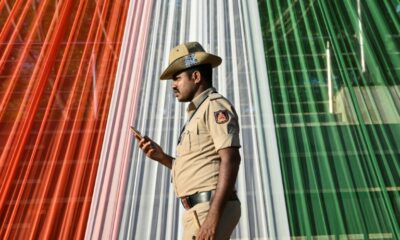World
Landslides and Floods Claim 63 Lives in Nepal and India

Heavy downpours in Nepal and northern India have resulted in the tragic deaths of at least 63 people as of Sunday, following a series of devastating landslides and floods. Rescue operations are currently underway to reach isolated communities that have been cut off by the severe weather.
In Nepal, the torrential rains began on September 29, leading to rivers swelling and inundating numerous areas. According to Shanti Mahat, a spokesperson for Nepal’s National Disaster Risk Reduction and Management Authority, at least 43 fatalities have been confirmed, with five individuals reported missing. The eastern district of Illam has been the hardest hit, with 37 people losing their lives due to landslides.
“Heavy rains overnight caused the landslides,” stated local district official Sunita Nepal. Rescue teams are facing challenges as blocked roads hinder access to affected areas. Workers are now making their way on foot to reach those in need. Additionally, the capital city of Kathmandu has seen rising river levels, which have flooded nearby settlements.
In response to the crisis, security personnel have been deployed to assist with rescue efforts, utilizing helicopters and motorboats. Vegetable seller Rajan Khadga, 38, shared that advance warnings allowed some residents to move belongings to safety. “There is some damage, but thanks to the authorities’ prior flood alert, we were able to move some belongings to a safe place,” he remarked.
Landslides have also disrupted transportation, blocking several highways and affecting flights. Many travelers have found themselves stranded, particularly those returning from the Hindu festival of Dashain. In a statement, Prime Minister Sushila Karki emphasized the government’s preparedness for rescue and relief operations. “Your safety is our utmost concern. Do not hesitate to seek necessary assistance,” she declared, announcing that Sunday and Monday would be designated public holidays and advising citizens to avoid unnecessary travel.
In India, the situation mirrors that of Nepal, with at least 20 fatalities reported in the tea-growing district of Darjeeling, West Bengal. Following heavy overnight rain, flash floods and landslides devastated homes and infrastructure. “In the wake of last night’s heavy cyclone in the Darjeeling hills, over 20 people have lost their lives,” said Harsh Vardhan Shringla, a member of India’s upper house of parliament. Dramatic footage from Indian news broadcasts showed rescue workers using cables to access regions cut off by the flooding.
Indian Prime Minister Narendra Modi expressed his sorrow over the loss of life, stating, “The situation in Darjeeling and surrounding areas is being closely monitored in the wake of heavy rains and landslides.”
Monsoon rains, typically occurring from June to September, result in widespread destruction across South Asia each year. However, the frequency and severity of fatal floods and landslides have escalated in recent years. Experts attribute this increase to climate change, which has intensified weather patterns.
The Kathmandu-based International Centre for Integrated Mountain Development warned in June that communities would face heightened disaster risks this monsoon season. “Rising temperatures and more extreme rain raise the risk of water-induced disasters such as floods, landslides, and debris flows,” the organization noted.
The ongoing weather crisis in Nepal and India highlights the urgent need for effective disaster preparedness and response strategies, particularly as climate change continues to reshape weather patterns across the region.
-

 Politics4 weeks ago
Politics4 weeks agoSecwepemc First Nation Seeks Aboriginal Title Over Kamloops Area
-

 World5 months ago
World5 months agoScientists Unearth Ancient Antarctic Ice to Unlock Climate Secrets
-

 Entertainment5 months ago
Entertainment5 months agoTrump and McCormick to Announce $70 Billion Energy Investments
-

 Science5 months ago
Science5 months agoFour Astronauts Return to Earth After International Space Station Mission
-

 Lifestyle5 months ago
Lifestyle5 months agoTransLink Launches Food Truck Program to Boost Revenue in Vancouver
-

 Technology3 months ago
Technology3 months agoApple Notes Enhances Functionality with Markdown Support in macOS 26
-

 Lifestyle3 months ago
Lifestyle3 months agoManitoba’s Burger Champion Shines Again Amid Dining Innovations
-

 Top Stories2 months ago
Top Stories2 months agoUrgent Update: Fatal Crash on Highway 99 Claims Life of Pitt Meadows Man
-

 Politics4 months ago
Politics4 months agoUkrainian Tennis Star Elina Svitolina Faces Death Threats Online
-

 Sports5 months ago
Sports5 months agoSearch Underway for Missing Hunter Amid Hokkaido Bear Emergency
-

 Politics5 months ago
Politics5 months agoCarney Engages First Nations Leaders at Development Law Summit
-

 Technology5 months ago
Technology5 months agoFrosthaven Launches Early Access on July 31, 2025





















